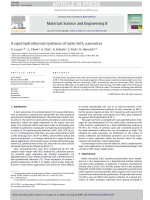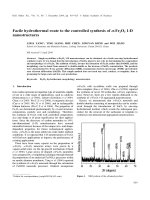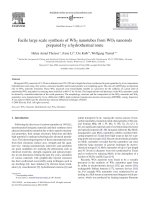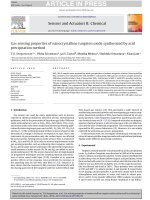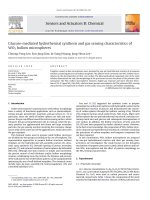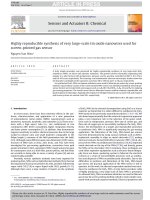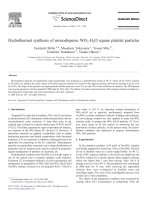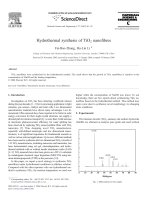- Trang chủ >>
- Khoa Học Tự Nhiên >>
- Vật lý
hydrothermal synthesis of tungsten oxide nanobelts
Bạn đang xem bản rút gọn của tài liệu. Xem và tải ngay bản đầy đủ của tài liệu tại đây (248.67 KB, 4 trang )
Hydrothermal synthesis of tungsten oxide nanobelts
Xuchun Song
a,
⁎
, Yang Zhao
b
, Yifan Zheng
c
a
Department of Chemistry, Fujian Normal University, Fuzhou 350007, P. R. China
b
Department of Chemistry, Henan Normal University, Xinxiang, 453002, P. R. China
c
Coll Chem Engn and Mat Sci, Zhejiang Univ Technol, Hangzhou, 310014, P. R. China
Received 29 January 2006; accepted 5 March 2006
Available online 3 April 2006
Abstract
Tungsten oxide nanobelts have been hydrothermally fabricated at 180 °C for 12 h with sodium sulfite and cetyltrimethylammonium bromide
(CTAB) as assisted, respectively. X-ray diffraction (XRD) pattern indicates that the as-prepared samples are the pure orthorhombic phase WO
3
.
EDS spectra show that the ratio of W/O is about 1:3. The morphology was characterized by scanning electron microscopy (SEM) and transmission
electron microscopy (TEM) techniques. Based on a series of comparative experiments under different reaction conditions, the probable formation
mechanism of tungsten oxide nanobelts is proposed.
© 2006 Elsevier B.V. All rights reserved.
Keywords: Hydrothermal; Tungsten oxide; Nanobelts
1. Introduction
As a new family of one-dimensional (1D) nanostructures,
nanobelts have attracted increasing attention because of their
unique physical properties and potential applications [1–5].
Although some nanobelts made of semiconductors, metals, and
other materials have been already synthesized in various ways
[6–10], the preparation of nanobelts under mild conditions
remains a considerable challenge.
WO
3
is a versatile wide band-gap semiconductor for many
valuable applications. To date, WO
3
has been one of the most
extensively studied materials for electrochromic devices, in-
formation displays, sensor devices and smart windows [11–13].
In addition, WO
3
has a high potential for the use in elec-
trochemical devices, such as rechargeable lithium batteries,
based upon its rich chemical intercalation reactivity. However,
studies of tungsten oxides nanobelts were comparatively rare
because of lack of preparation methods for such materials. Very
recently, Li et al. met the challenge and developed a sim ple
method to prepare tungsten oxide nanobelts via physical vapor
deposition process [14]. In this work, we successfully synthe-
sized tungsten oxide nanobelts via a Na
2
S and CTAB as assisted
by a hydrothermal method at 180 °C. This strategy may offer an
opportunity for the further investigation of some fundamental
properties of 1D tungsten oxides and may also serve as a general
method for the synthesis of 1D nanostructure.
2. Experimental
2.1. Sample preparation
CTAB (0.8 g) was dissolved in 35 ml deionized water to
form a transparent solution. Then 0.3 g H
2
WO
4
powder and
5 ml HCl (3 M) were added to the above solution under con-
tinuous stirring. The resulting suspension was transferred into a
50 ml Teflon-lined stainless steel autoclave. Then 1.2 g Na
2
S
powder was added to Teflon-lined stainless steel autoclave and
sealed tightly. Hydrothermal treatments were carried out at
180 °C for 12 h. After that, the autoclave was allowed to cool
down naturally. Precipitates were collected, and washed with
deionized water several times and dried in air at 80 °C.
2.2. Characterization
The morphologies were charac terized using sca nning
electron microscopy (SEM, Hitachi S-4700 II, 25 kV) and
transmission electron microscopy (TEM, JEM200CX, 120 kV).
Materials Letters 60 (2006) 3405 – 3408
www.elsevier.com/locate/matlet
⁎
Corresponding author.
E-mail address: (X. Song).
0167-577X/$ - see front matter © 2006 Elsevier B.V. All rights reserved.
doi:10.1016/j.matlet.2006.03.022
The composition of the product was an alyzed by energy dis-
persive X-ray detector (EDX, Thermo Noran VANTAG-ESI,
120 kV). The X-ray diffraction (XRD, Thermo ARL SCINTAG
X'TRA with CuKα irradiation, λ = 0.154056 nm.) was used to
analyze the crystallinity.
3. Results and discussion
The morphologies of as-prepared WO
3
nanobelts were determined
by SEM and TEM (Fig. 1). Fig. 1a and b shows the typical patterns of
WO
3
nanobelts prepared via the hydrothermal route by using CTAB
and Na
2
S as assisted; these WO
3
nanobelts have a typically curly
morphology with a length from 1 μm to over 3 μm and a width of 30–
100 nm; the thickness of the belts is about 15 nm. The product was
further characterized by TEM accompanied by selected area electron
diffraction (SAED) and shown in Fig. 1c and d. The result also shows
that the WO
3
nanobelts assemble together with some curly morphol-
ogy. The corresponding SAED pattern displays its single crystalline
nature and could be indexed to the pure orthorhombic WO
3
and shows
the growth direction along the [200].
The electron-induced X-ray fluorescence (EDS) analysis was em-
ployed to determine the composition of the tungsten oxide nanobelts. As
shown in Fig. 2, only oxygen and tungsten elements existed in the
nanobelts with the molar ratio of about 3 (O/W). In Fig. 3, a represen-
tative XRD pattern for our assynthesized tungsten oxide nanobelts is
displayed. All the main peaks can be indexed undisputedly to ortho-
rhombic WO
3
(JCPDS card 20-1324). This agrees well with the SADE
results. No impurities could be detected in this pattern, which implies
that pure WO
3
could be obtained under the current synthetic route.
The morphologies of WO
3
nanocrystals synthesized in different
reaction conditions were shown in Fig. 4a–d. When 1.2 g Na
2
S and
5 ml HCl (3 M) were added into the reaction systems without addition
of CTAB, the prepared WO
3
agglomerated together severely (shown in
Fig. 4a). However, if we just added CTAB not Na
2
S, the nanolamellars
and short nanobelts in the sample were shown in the Fig. 4b. The result
indicated that nanocrystals dispersed well in the presence of CTAB and
the morphologies of WO
3
were independent of the HCl. When 1.2 g
Na
2
S and 0.8 g CTAB were added at the same time, the morphologies
Fig. 1. (a) SEM, (b) SEM, (c) TEM, (d) TEM images of WO
3
nanobelts.
Fig. 2. EDS patterns of WO
3
nanobelts. Fig. 3. XRD patterns of WO
3
nanobelts.
3406 X. Song et al. / Materials Letters 60 (2006) 3405–3408
of WO
3
synthesized with 7 and 10 ml HCl (3 M) were shown in Fig. 4c
and d individually. Compared with Fig. 1c (5 ml HCl), it can be known
that with the content of HCl decreased, the length and outcome of WO
3
nanobelts in the products increased accordingly. But when the content
of HCl decreased further, the products were the Na
2
WS
4
solution not
the WO
3
precipitates during the hydrothermal reaction. From the re-
sults, it can be concluded that addition of Na
2
S and CTAB at the same
time is important and both of them affect corporately on the formation
of WO
3
nanobelts.
The growth mechanism of crystal is determined by both the internal
structure and external conditions such as temperature, pressure, and
composition of the solution [15]. A possible mechanism has been
proposed to explain the nanobelts growth in thermal evaporation. Since
our situation is quite different from the dry method, the explanation of
the nanobelts growth mechanism in hydrothermal condition remains
speculative. It is well known that the shape of the nanocrystals can be
controlled by adding chemical capping reagents into the solution. The
selective interaction of the capping molecules on the facets of the first-
formed nanoparticles is crucial to the anisotropic growth of nano-
structures. For example, we have chosen a CTAB as the capping
molecules in our experiments, and found that the CTAB has a great
influence on the morphology of WO
3
nanostructures. In addition, it has
been known that the superposition of growth units on crystal surfaces
strongly affects the growth speed and orientation of crystals. The size
and structure for growth units depend on the hydrothermal reaction
conditions. The addition Na
2
S and proper content of HCl produced
different kinds of stable growth units (H
2
WO
4−x
S
x
). The growth units
were more stable, the probability for which existed in the systems was
bigger [16]. The stable growth units grew preferentially along the
crystal face (200) and produced the nanobelts in the end. Moreover, it
could be found that the sulfur element was removed as the stable
growth units (H
2
WO
4−x
S
x
) superposed on the crystal surfaces. The
result predicted that the site for sulfur in the growth units (H
2
WO
4−x
S
x
)
would be the active site for the growth of crystal along the crystal face
(200). In a word, both Na
2
S and CTAB acted corporately during the
formation of WO
3
nanobelts.
4. Conclusion
In conclusion, large quantity and single crystalline WO
3
nanobelts have been synthesized through a hydrothermal
method. Structural characterization by SEM and TEM revealed
that the WO
3
nanobelts possess orthorhombic with [200]
growth orientati on. A possi ble mechanism was proposed that
Na
2
S and CTAB acted corporately on the formation of WO
3
nanobelts. The effect should be able to be extend ed to the
synthesis of other 1D nanomaterial.
Acknowledgments
We wish to acknowledge the financial support from the
Foundation of Educational Committee of Fujian Province (No:
K04027).
References
[1] K. Balakrishnan, A. Datar, R. Oitker, H. Chen, J. Zuo, L. Zang, J. Am.
Chem. Soc. 127 (2005) 10496.
[2] A. Pan, H. Yang, R. Liu, R. Yu, B. Zou, Z. Wang, J. Am. Chem. Soc. 127
(2005) 15692.
[3] X. Bai, E.G. Wang, P. Gao, Z.L. Wang, Nano Lett. 3 (2003) 1147.
[4] P. Hu, Y. Liu, L. Fu, L. Cao, D. Zhu, J. Phys. Chem., B 108 (2004)
936.
[5] M.H. Zhao, Z.L. Wang, S.X. Mao, Nano Lett. 4 (2004) 587.
[6] J. Duan, S. Yang, H. Liu, J. Gong, H. Huang, X. Zhao, R. Zhang, Y. Du,
J. Am. Chem. Soc. 127 (2005) 6180.
[7] X. Wang, Y. Ding, C.J. Summers, Z.L. Wang, J. Phys. Chem., B 10 (2004)
8773.
[8] X. Sun, X. Chen, Y. Li, Inorg. Chem. 41 (2002) 4996.
[9] Z. Kang, E. Wang, B. Mao, Z. Su, L. Gao, S. Lian, L. Xu, J. Am. Chem.
Soc. 127 (2005) 6534.
[10] Q. Wu, Z. Hu, X. Wang, Y. Chen, Y. Lu, J. Phys. Chem., B 107 (2003)
9726.
Fig. 4. TEM images of WO
3
nanocrystals in different reaction conditions: (a) 1.2 g Na
2
S and 5 ml HCl (3 M) without CTAB, (b) CTAB without Na
2
S, (c) (d) 1.2 g
Na
2
S and 0.8 g CTAB with 10 ml and 7 ml HCl (3 M) individually.
3407X. Song et al. / Materials Letters 60 (2006) 3405–3408
[11] B. Tang, J.C. Ge, C.J. Wu, L.H. Zhuo, Z.Z. Chen, Z.Q. Shi, Nanotech-
nology 15 (2004) 1273.
[12] X.F. Duan, Y. Huang, Y. Cui, J.F. Wang, C.M. Lieber, Nature 409 (2001)
66.
[13] C. Santato, M. Odziemkowski, M. Ulmann, J. Augustynski, J. Am. Chem.
Soc. 123 (2001) 10639.
[14] Y.B. Li, Y. Bando, D. Golberg, K. Kurashima, Chem. Phys. Lett. 367
(2003) 214.
[15] X.Y. Zhang, J.Y. Dai, H.C. Ong, N. Wang, H.L.W. Chan, C.L. Choy,
Chem. Phys. Lett. 393 (2004) 17.
[16] E.W. Shi, C.T. Xia, B.G. Wang, J. Inorg. Mater. 11 (1996) 193.
3408 X. Song et al. / Materials Letters 60 (2006) 3405–3408
